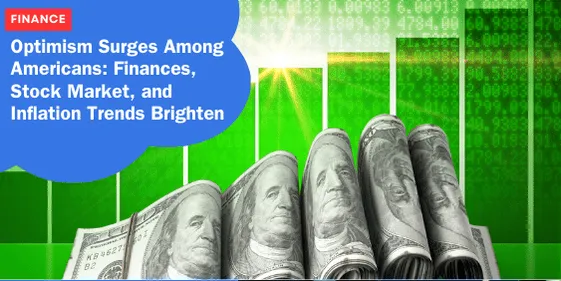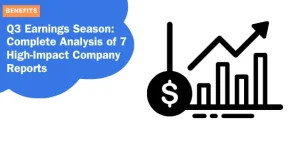Optimism Surges Among Americans: Finances, Stock Market, and Inflation Trends Brighten

In recent presidential election polls, while some Americans express mixed or even negative views on the overall state of the economy, there is a notable contrast when it comes to personal finances.
Numerous American consumers currently hold optimistic views regarding their financial status, the stock market, and the trajectory of inflation.
This sentiment is reflected in survey data released on Monday by the Federal Reserve Bank of New York.
The New York Fed’s May Survey of Consumer Expectations revealed an improvement in how people perceive their current financial status as well as their optimism for the future.
Respondents who felt their financial situation was better than in May 2023 reached the second-highest level in more than two years.
Additionally, the share of people with a positive outlook for the coming year hit a nearly three-year high.
A Shift in Consumer Confidence
Financial Standing: Current and Future Outlook
The New York Fed’s latest survey points to an upward shift in consumer confidence.
Not only has there been an increase in the number of individuals who feel better about their financial standing compared to a year ago, but optimism about future financial conditions has also surged.
This renewed confidence can have significant implications for the broader economy.
Remarkable Stock Market Expectations
Adding to this optimistic outlook, consumers are showing increased confidence in the stock market’s continuing rally.
Households’ expectations for future US stock prices have improved, reaching a peak not seen in three years.
This belief in the market’s resilience underscores the broader sentiment of economic optimism.
Mixed Signals from the Labor Market
Earnings Growth and Unemployment Concerns
While positive sentiments abound regarding personal finances and the stock market, the labor market presents a more nuanced picture.
The survey indicated a slight dip in earnings growth expectations. Concurrently, there was an increase in the perceived probability of a higher national unemployment rate in the following year, surpassing the 12-month trailing average.
Job Security Perceptions
Contrastingly, despite concerns about a potential rise in the national unemployment rate, the probability of individuals losing their jobs decreased below the 12-month average.
This contradiction suggests that while people might be slightly pessimistic about the broader job market, they feel secure in their personal employment situations.
Housing Market and Inflation Trends
Unchanged Home Price Expectations
In May, expectations for home prices remained high, with no change from the previous month.
The sentiment towards real estate reflects ongoing concerns about affordability and the housing market’s trajectory.
However, these static expectations do not necessarily spell bad news.
Dipping Inflation Expectations: A Positive Indicator
Crucially, May saw a dip in year-ahead inflation expectations, a promising sign for the Federal Reserve.
The Fed pays close attention to near-, medium-, and long-term inflation expectations due to their potential to become self-fulfilling.
When consumers expect higher prices, they may choose to spend more immediately or demand higher wages, prompting businesses to raise prices due to increased costs.
This phenomenon can perpetuate inflationary pressures, making a dip in expectations a welcome development.
Stability in Three- and Five-Year Inflation Expectations
The survey also showed that inflation expectations for three and five years ahead remained unchanged.
This stability suggests that consumers believe inflationary pressures will moderate in the longer term.
Anticipated CPI Report and Its Implications
Upcoming Inflation Data
The US is set to receive crucial insights into the state of inflation this week with the release of the May Consumer Price Index (CPI) on Wednesday morning.
This widely used inflation gauge is expected to show a slowdown in consumer prices on a monthly basis, indicating a cooling of a key underlying inflation metric.
Potential Impact of CPI Data
A favorable CPI report would be welcome news for Americans who have been contending with over three years of elevated inflation.
Additionally, it would support the Federal Reserve in its ongoing efforts to control price hikes, and positively impact the stock market.
Significantly, when the April CPI showed a slower rate of inflation than earlier in the year, major US stock indexes soared to record highs.
The Broader Economic Landscape
Consumer Spending Patterns
Alongside these critical indicators, patterns in consumer spending also offer valuable insights.
Recent data highlight that Americans’ spending habits are shifting, with a potential slowdown in consumer engagement.
This trend has been reflected in the behavior of major retailers, which have started cutting prices to attract budget-conscious shoppers.
Real Estate Dynamics
In the real estate sector, the anticipation of rising home prices continues to define consumer expectations.
While high home price expectations indicate robust demand and market confidence, they also underscore concerns about affordability and long-term sustainability in the housing market.
Strategic Implications for Investors
Emphasis on Diversification
Given the current economic landscape, diversifying investments across various sectors is a prudent strategy.
While some industries may face challenges due to prevailing economic conditions, others present promising growth opportunities.
Diversifying investments enables investors to mitigate risks and enhance portfolio stability.
High-Quality Stock Selection
Investors are advised to focus on high-quality stocks, particularly those with strong balance sheets and robust cash generation capabilities.
Companies with minimal reliance on external financing are better positioned to navigate high-interest rate environments and economic volatility.
Long-Term Investment Perspective
Maintaining a long-term investment perspective is crucial in the current economic climate.
While short-term market fluctuations may trigger volatility, focusing on long-term fundamentals allows investors to weather temporary disruptions and capitalize on growth opportunities over time.
Patience and strategic positioning can yield favorable returns in resilient sectors.
Conclusion: Navigating the Future with Optimism
In conclusion, Americans’ optimism regarding their finances, the stock market, and inflation trends provides a positive outlook for the near future.
Understanding the implications of sustained higher-for-longer rates and recognizing vulnerable and growth sectors are essential components of a successful investment strategy.
The resilience of sectors such as technology, energy, and utilities underscores the dynamic nature of the market.
As investors adapt to the evolving economic landscape, adhering to diversification strategies, prioritizing high-quality stocks, and maintaining a long-term perspective will be paramount.
With thoughtful planning and continuous monitoring of economic indicators, investors can effectively manage their portfolios, capitalize on emerging opportunities, and mitigate risks.
A well-informed approach to investing in this optimistic yet complex environment can pave the way for sustained growth and financial success.






